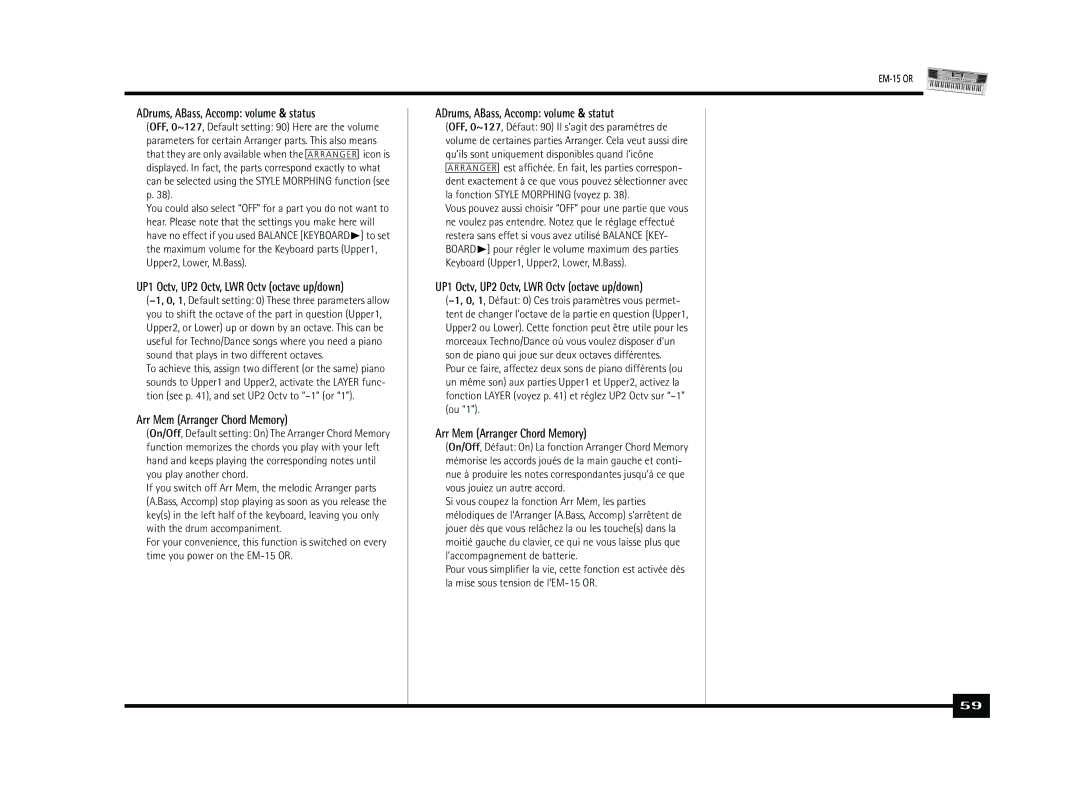English/Français/Arabic
EM-15 or
Caractéristiques
Features
Quatre modes
Music Styles
Four modes
Styles musicaux
Sommaire
Contents
Remarques importantes
Important notes
Précautions supplémentaires
Additional precautions
Description des panneaux
Press this button to switch the EM-15 or on and off
Panel descriptions
Use these buttons to set the global volume of your EM-15 or
See
ONE Touch buttons 1-2
Tempo -/+, DATA, YES/NO buttons
DRUMS, ORGAN, ARRANGER, Piano buttons
Melody INT/LAYER button
DC 12V in socket
Sustain Footswitch socket
Prise Sustain Footswitch
Midi OUT/IN sockets
Playback of all demo songs
Setting up
Branchements
Demo songs Morceaux de démo
Reproduction d’une démo de styles
Playback of a Tone demo song
Reproduiction d’une démo de sons
Playback of a Style demo song
Jeux musicaux
Game function
Appuyez sur Style Morphing Bass
Press Style Morphing Bass
Guess Tone deviner le son
Guess Tone
Guess Style deviner le style
Guess Style
Pour spécifier la tonique Root
Chord Finder
To specify the Root
Jouez à nouveau l’accord et appuyez sur OK
To specify the Type
Message 2 Type
Pour spécifier le type
Paniment Gnement
Jeu avec accompa
Changer le tempo
Changing the tempo
Démarrage automatique du jeu Sync Start
Stopping Arranger playback
Arrêter le jeu de l’Arranger
Automatic playback start Sync Start
Locate the Tone sound you need Ver le son Tone recherché
Ing Droite Press the Tone button Appuyez sur le bouton Tone
You can now select Tones
On the right-hand side of front panel to
Organ
Partage de clavier
Utilisation du métronome
Using the metronome
Playing one sound Jeu avec un son Piano
Abaisser la hauteur de certaines notes d’un quart de ton
Using oriental tunings
Tuning individual notes a quarter tone down
Utilisation d’accords orien- taux
Utilisation d’autres valeurs d’accord
Using other tuning values
Saving and loading your tunings Scale Memory
EM-15 or
Utilisation des boutons Pitch Shift
Using the Pitch Shift buttons
Choix d’un autre Drum Set
Drumming on the keyboard
Jouer de la batterie sur le clavier
Selecting other Drum Sets
Recording your music 10. Enregistrer votre jeu
Start recording in one of the following ways
Assign the desired Tone to the right half of the keyboard
Assignez le son voulu à la moitié droite du clavier
Press the REC button once or twice to select the REC icon
Deuxième enregistrement
Listening to your song Ecoute de votre morceau
Second recording pass
Melody by pressing the M.DRUMS button
La fonction One Touch automatise plusieurs tâches
Additional Music Style functions
One Touch
One Touch function automates quite a few tasks
Changer le son Melody INT
Melody Intelligence INT
Changing the Melody INT Tone
Orchestrator
Style Morphing
Choix d’un autre style B
Press it again to return to the previous bass part
Selecting another B Style
Autres fonctions des styles musicaux
Additional Music Style functions
Utiliser deux parties Upper Layer
Using two Upper parts Layer
More Keyboard part functions
Autres fonctions de parties Keyboard
Choix de variations de sons
Selecting Tone Variations
Balance
Relâchez le bouton Transpose
Transpose
Release the Transpose button
Box that surrounds the Transpose message disap- pears
Autres fonctions liées aux parties Keyboard
Other Keyboard part functions
Fonctions de reproduction
Recorder functions
Fonctions Recorder
Playback functions
Jeu live avec accompagnement de morceau Minus One
Live performance with song backing Minus One
Première prise d’enregistrement
Other recording modes
Autres modes d’enregistrement
First recording pass
Deuxième prise d’enregistrement
Enregistrement en mode Piano
Recording in Piano mode
Arranger Drums Upper Upper 2 via Layer
Enregistrement en mode M.DRUMS
Recording in M.DRUMS mode
Autres options d’enregistrement mode Song
Other recording options Song mode
Changer le tempo du morceau
Changing the song tempo
Menu Function
La flèche de mode clignote à présent à l’écran
Editing parameters general procedure
Function menu
Disparaît
Velocity sensitivity. In that case, the icon disappears
RevType Reverb Type
Metro Vol metronome volume
Metro Vol volume du métronome
Reverb
MBass statut et volume
Upper 1, Upper 2, Lower volume & status
MBass status and volume
Upper 1, Upper 2, Lower volume & statut
Arr Mem Arranger Chord Memory
ADrums, ABass, Accomp volume & status
ADrums, ABass, Accomp volume & statut
UP1 Octv, UP2 Octv, LWR Octv octave up/down
LWR Mem Lower Chord Memory
MBassSwt M. Bass switch
Chrd Int Chord Intelligence
Minus One
ArrSplit Arranger Split
LwrSplit Lower Split
Scale C~B
PitchBnd
BPM Lock
Scale Tune
Resume
Enregistrer les réglages dans un pro- gramme utilisateur
Writing your settings to a User Program
Working with User Programs
Tirer parti des programmes utilisateur
Meaning of the dashes below the User Program number
Mode selection
Sélection de mode
Leaving the User Program environment
Sélection d’un programme utilisateur
Selecting a User Program
To actually select a User Program… Press a numeric button
Branchez l’EM-15 or comme montré ci-dessus
Midi functions
Fonctions Midi
Connect your EM-15 or as shown above
Midi TxRx transfert et réception Midi
Midi Function parameters
Midi TxRx Midi transmission and reception
Paramètres de fonction Midi
NTA Rx14 activation/coupure de réception NTA
NTA Rx14 Note-to-Arranger reception on/off
Style PC Style Select TxRx Channel
Sync Rx Midi synchronization
Song Pos P Song Position Pointer
Clock Tx
StartStp Start/Stop/Continue
Local
Using an external amplifier
Using the outputs and an optional pedal
Commutateur au pied de Sustain
Sustain Footswitch
Fonctions à caractère pédagogique
Miscellaneous
Divers
Functions for educational purposes
Verrouillage de l’Arranger et de la fonction Demo
Initializing your EM-15 or Factory
Initialiser l’EM-15 or Factory
Deactivating both the Arranger and the Demo function
Remerciments
Thanks
Fiche technique
Specifications
Tone List
B48 SweepPad B77 119 SynthDrm B87 127 Applause B51 Ice Rain
Music Style list
Drum Sets
Orient
Midi Implementation Chart
Model EM-15 or Version
Numerics
Index

